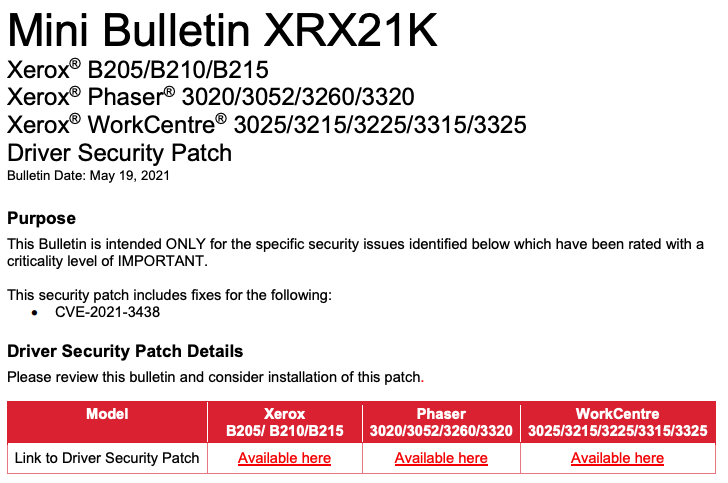Executive Summary
- SentinelLabs has discovered a high severity flaw in HP, Samsung, and Xerox printer drivers.
- Since 2005 HP, Samsung, and Xerox have released millions of printers worldwide with the vulnerable driver.
- SentinelLabs’ findings were proactively reported to HP on Feb 18, 2021 and are tracked as CVE-2021-3438, marked with CVSS Score 8.8.
- HP released a security update on May 19th to its customers to address this vulnerability.
As part of our commitment to secure the internet for all users, our researchers have engaged in an open-ended process of vulnerability discovery for targets that impact wide swaths of end users. Our research has been consistently fruitful, particularly in the area of OEM drivers[1, 2]. Many of these drivers come preloaded on devices or get silently dropped when installing some innocuous legitimate software bundle and their presence is entirely unknown to the users. These OEM drivers are often decades old and coded without concern for their potential impact on the overall integrity of those systems.
Our research approach has allowed us to proactively engage with vendors and manufacturers to patch previously unknown vulnerabilities before they can be exploited in the wild. We will continue our efforts to reduce the overall attack surface available to cunning adversaries.
Discovering an HP Printer Driver Vulnerability
Several months ago, while configuring a brand new HP printer, our team came across an old printer driver from 2005 called SSPORT.SYS thanks to an alert by Process Hacker once again.

This led to the discovery of a high severity vulnerability in HP, Xerox, and Samsung printer driver software that has remained hidden for 16 years. This vulnerability affects a very long list of over 380 different HP and Samsung printer models as well as at least a dozen different Xerox products.


Since all of these models are in fact manufactured by HP, we reported the vulnerability to them.
Technical Details
Just by running the printer software, the driver gets installed and activated on the machine regardless of whether you complete the installation or cancel.

Thus, in effect, this driver gets installed and loaded without even asking or notifying the user. Whether you are configuring the printer to work wirelessly or via a USB cable, this driver gets loaded. In addition, it will be loaded by Windows on every boot:

This makes the driver a perfect candidate to target since it will always be loaded on the machine even if there is no printer connected.
The vulnerable function inside the driver accepts data sent from User Mode via IOCTL (Input/Output Control) without validating the size parameter:

This function copies a string from the user input using strncpy with a size parameter that is controlled by the user. Essentially, this allows attackers to overrun the buffer used by the driver.
An interesting thing we noticed while investigating this driver is this peculiar hardcoded string: "This String is from Device Driver@@@@ ".

It seems that HP didn’t develop this driver but copied it from a project in Windows Driver Samples by Microsoft that has almost identical functionality; fortunately, the MS sample project does not contain the vulnerability.
Impact
An exploitable kernel driver vulnerability can lead an unprivileged user to a SYSTEM account and run code in kernel mode (since the vulnerable driver is locally available to anyone). Among the obvious abuses of such vulnerabilities are that they could be used to bypass security products.
Successfully exploiting a driver vulnerability might allow attackers to potentially install programs, view, change, encrypt or delete data, or create new accounts with full user rights. Weaponizing this vulnerability might require chaining other bugs as we didn’t find a way to weaponize it by itself given the time invested.
Suggestions
Generally speaking, it is highly recommended that in order to reduce the attack surface provided by device drivers with exposed IOCTLs handlers, developers should enforce strong ACLs when creating kernel device objects, verify user input and not expose a generic interface to kernel mode operations.
Remediation
This vulnerability and its remedies are described in HP Security Advisory HPSBPI03724 and Xerox Advisory Mini Bulletin XRX21K. We recommend HP/Samsung/Xerox customers, both enterprise and consumer, to apply the patch as soon as possible.
To mitigate this issue users should use this link and look for their printer model and then download the patch file as shown in the picture:

Some Windows machines may already have this driver without even running a dedicated installation file, since the driver comes with Microsoft Windows via Windows Update:

Note: Not all affected products were initially listed on the advisory page. We initially conducted a small sample test and found other products vulnerable, so we recommend further verification.
Conclusion
This high severity vulnerability, which has been present in HP, Samsung, and Xerox printer software since 2005, affects millions of devices and likely millions of users worldwide. Similar to previous vulnerabilities we have disclosed that remained hidden for 12 years (1, 2), the impact this could have on users and enterprises that fail to patch is far-reaching and significant.
While we haven’t seen any indicators that this vulnerability has been exploited in the wild up till now, with millions of printer models currently vulnerable, it is inevitable that if attackers weaponize this vulnerability they will seek out those that have not taken the appropriate action.
We would like to thank HP for their approach to our disclosure and for remediating the vulnerabilities quickly.
Disclosure Timeline
18 Feb, 2021 – Initial report.
23 Feb, 2021 – We notified HP that the same issue exists in Samsung and Xerox printers.
19 May, 2021 – HP released an advisory for CVE-2021-3438.
20 May, 2021 – We notified HP that the “affected products” listing is incomplete and provided extra information.
01 Jun, 2021 – HP updated the list of affected products.




